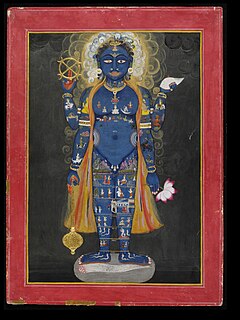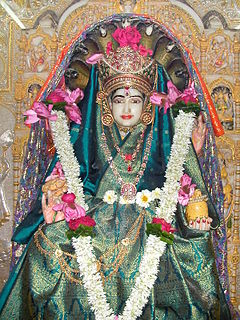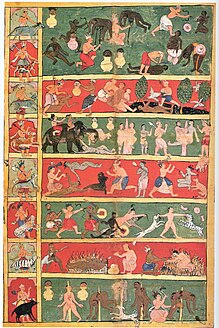Jainism, traditionally known as Jain Dharma is an ancient Indian religion. Followers of Jainism are called "Jains", a word derived from the Sanskrit word jina (victor) who connotes the path of victory in crossing over life's stream of rebirths by destroying the karma through an ethical and spiritual life. Jainism is a transtheistic religion, and Jains trace their spiritual ideas and history through a succession of twenty-four victorious saviours and teachers known as tirthankaras, with the first being Rishabhanatha, who according to Jain tradition lived millions of years ago, the twenty-third being Parshvanatha in 900 BCE, and twenty-fourth being the Mahāvīra around 500 BCE. Jains believe that Jainism is an eternal dharma with the tirthankaras guiding every cycle of the Jain cosmology. Their religious texts are called Agamas.

The Dilwara Temples or Delvada Temples are located about 2½ kilometres from the Mount Abu settlement, Rajasthan's only hill station. These Jain temples were built by Vimal Shah and designed by Vastupala, Jain ministers of Dholka, between the 11th and 16th centuries and are famous for their use of white marble and intricate marble carvings. They are a pilgrimage place of the Jains, and a popular general tourist attraction. Some consider them to be one of the most beautiful Jain pilgrimage sites in the world. The temples have an opulent entranceway, the simplicity in architecture reflecting Jain values like honesty and frugality. The temples are in the midst of a range of forested hills. A high wall shrouds the temple complex.
Religious cosmology is an explanation of the origin, evolution, and eventual fate of the universe, from a religious perspective. This may include beliefs on origin in the form of a creation myth, subsequent evolution, current organizational form and nature, and eventual fate or destiny. There are various traditions in religion or religious mythology asserting how and why everything is the way it is and the significance of it all. Religious cosmologies describe the spatial lay-out of the universe in terms of the world in which people typically dwell as well as other dimensions, such as the seven dimensions of religion; these are ritual, experience and emotional, narrative and mythical, doctrinal, ethical, social, and material. Religious mythologies may include descriptions of an act or process of creation by a creator deity or a larger pantheon of deities, explanations of the transformation of chaos into order, or the assertion that existence is a matter of endless cyclical transformations. Religious cosmology differs from a strictly scientific cosmology informed by the results of the study of astronomy and similar fields, and may differ in conceptualizations of the world's physical structure and place in the universe, its creation, and forecasts or predictions on its future. The scope of religious cosmology is more inclusive than a strictly scientific cosmology in that religious cosmology is not limited to experiential observation, testing of hypotheses, and proposals of theories; for example, religious cosmology may explain why everything is the way it is or seems to be the way it is and prescribing what humans should do in context. Variations in religious cosmology include those of Indian origin, such as Buddhism, Hindu, and Jain; the religious beliefs of China; and, the beliefs of the Abrahamic faiths, such as Judaism, Christianity, and Islam. Religious cosmologies have often developed into the formal logics of metaphysical systems, such as Platonism, Neoplatonism, Gnosticism, Daoism, Kabbalah, or the great chain of being.

In Hindu cosmology, the universe is cyclically created and destroyed. Its cosmology divides time into four epochs or Yuga, of which the current period is the Kali Yuga.

Jain symbols are symbols based on the Jain philosophy.

Sonagiri about 60 km from Gwalior, has scores of Jain temples dating from the 9th century onwards. It is located in the Datia district of Madhya Pradesh, India. This location is popular among devotees and ascetic saints to practice self-discipline, austerity and to attain Moksha. This place also has a Jain museum.

Anjaneri, one of the forts in the mountain range of Nasik-Trimbakeshwar, is considered to be the birthplace of god Hanuman. Anjaneri is located 20 km away from Nasik by Trimbak Road. It has become a famous trekking spot for local Nashikites, specially in the rainy season.

Ranakpur Jain temple or Chaturmukha Dharana Vihara is a Jain temple at Ranakpur is dedicated to Tirthankara Rishabhanatha. The temple is located in a village of Ranakpur near Sadri town in the Pali district of Rajasthan.
The history of Jainism in Africa is relatively short when compared with the histories of Judaism, Christianity and Islam on the same continent. There are about 20,000 Jains and around 10 Jain organizations in Africa.
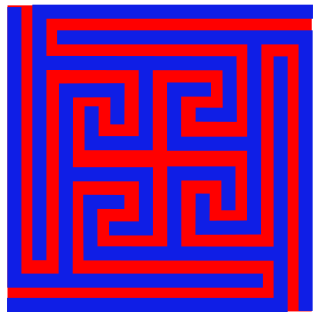
The Nandavarta or Nandyavarta is one of the eight auspicious symbols of Jainism for the Svetambara sect. It is an ashtamangala which is used for worship, and could be made with rice grains. It is also the symbol of 18th Tirthankar Aranatha according to Śvētāmbara and 7th tirthankar Suparshvanatha according to digambar. The symbol has 4 arms with compulsorily 9 corners/ turns each.

Bharata was the first chakravartin of avasarpini. He was the eldest son of Rishabhanatha, the first Tirthankara of Jainism. According to the Jains and the Hindu Puranas, the ancient name of India was named "Bhāratavarsha" or "Bhārata" or "Bharata-bhumi" after him. He had two sons from his chief Queen Sunanda - Arkakirti and Marichi. He conquered all the six parts of the world and fought with Bahubali in the end to conquer the last remaining city.

Ahinsa Sthal is a Jain temple located in Mehrauli, Delhi. The main deity of the temple is Mahavira, the 24th and last Tirthankara of Avasarpiṇī. A magnificent statue of Tirthankara Mahāvīra is installed here.

Gajpanth is a Digambar Jain pilgrimage site (Siddha-kshetra) located in Mhasrul village, in the Nashik district of the Indian state of Maharashtra. It's managed and maintained by Registered Trust No. A-193/NSK.

Aryika, also known as Sadhvi, is a female mendicant (nun) in Jainism.

Jain Basadi complex in Halebidu, Hassan district consists of three Jain Basadis dedicated to the Jain Tirthankars Parshvanatha, Shantinatha and Adinatha. The complex is situated near Kedareshwara temple and Dwarasamudra lake. These temples were constructed in 12th century during the reign of Hoysala Empire along with Kedareshwara temple and Hoysaleswara Temple have been proposed to be listed under UNESCO World Heritage Site.

The Jain Temple complex is group of 31 Jain temples located at Deogarh in Lalitpur district, Uttar Pradesh built around 8th to 17th century CE. The Jain complex in Deogarh are protected by the Department of Archaeology of the Archaeological Survey of India (ASI), and managed through its Northern Circle Office located in Lucknow. ASI maintain an archaeological museum at the Deogarh site, which is noted for its treasured archaeological sculptures.
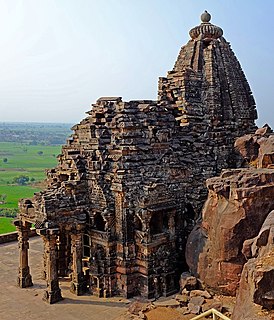
Vidisha is considered to be Puranakshetras Jain tirtha. The Jain temples are located in Vidisha district in state of Madhya Pradesh, India. Vidisha is believed to be birth place of Shitalanatha, the eleventh tirthankar. Here the first 108 feet elevated temple with all tirthankars with Shitalanatha as principal deity is also being constructed.


